You are currently browsing the tag archive for the ‘Veena’ tag.
Today is the tenth, and the last day of Navaratri – Vijaya Dashami. As per the Ramayana, this is the day when Rama defeated Ravana, and as per the Mahabharata, this is the day, on which Pandava’s ended their incognito. This is also the day on which Goddess Chamundeshwari slaying demon Mahisha.
Goddess Chamundeshwari, atop the Chamundi Hill at Mysore was the royal deity when the Odeyars ruled Mysore. The Odeyars of Mysore started the Dasara celebrations more than 400 years ago, which they had carried carried forward from the Kings of Vijayanagara.
The last ruler of Mysore, Sri Jayachamarajendra Odeyar was a musican and vaggeyakara himself and has composed about 100 compositions. His guru, Mysore Vasudevacharya is also one the most important composers of the 20th century. He composed more than 300 compositions – most of them in Samskrta and Telugu. He belongs to the musical tradition of Tyagaraja. Since Vausdevacharya’s compositions are very much on Tyagaraja’s lines, he is often called ‘Abhinava Tyagaraja’.
On this day when Goddess Chamundeshwari goes in the Dasara procession at Mysore, what could be better than listening to a composition about Goddess Chamundeshwari of Mysore, composed by Mysore Vasudevacharya, and played on the Veena by Mysore Doreswamy Iyengar?
Set in a bright and majestic raga, Bilahari, I think this composition the conclusion for the festivities of the season. Click on the image below, and enjoy this musical feast!
It was indeed wonderful to write the posts in the series “Veena Navartri” during Navaratri 2014, and in that process listen to some excellent music and become familiar with some new artists as well.
I wish all visitors of “ಅಲ್ಲಿದೆ ನಮ್ಮ ಮನೆ” for an year full of happiness and you the very best in your lives.
-neelanjana
p.s: Generally, I am careful about giving image credits. However, for this “Veena Navaratri”, I could not do that and idid not cite image sources. Just wanted to acknowledge this fact, All images belong to their respective copyright holders.
Today, 9/25/2014 is the second day of Navaratri. In the post I wrote yesterday for the first day of Navaratri, I was talking about how the term Veena was a generic term to any string instrument. But now, the term refers to the species of the instrument which is sometimes called “Saraswati Veena“.
In older texts we find references to Veenas with fixed and movable frets. The north Indian Sitar, is indeed a “Veena” with movable frets. Also, the position of how the Sitar is held is typically how Veenas were played in the past. That is the reason why you see most of the sculptures of Saraswati, who is often shown as holding a Veena in the same position.
In the painting of Saraswati by Raja Ravivarma, what you see is a Saraswati Veena, which came into vogue during the early 17th century. This Veena was the handiwork of Govinda Dikshita, who was a minister at the Tanjavur court. He named the Veena after the King who ruled Tanjavur at that time (Raghunatha Veena), but the name has morphed into Saraswati Veena later on.
Today, the composition I am writing about is of the vainika-gayaka composer – Muttuswamy Dikshita.
Muttuswamy Dikshita was a strict follower of the school of Govinda Dikshita (unrelated to him though!) and composed in all ragas that were described by Venkatamakhi ( Govinda Dikshita’s son) and Muddu Venkatamakhi ( Grand nephew of Venkatamakhi) in their texts such as Chaturdandi Prakashika and Ragalakshana. In this process, he resurrected some of the previously well-known ragas that were becoming somewhat rarely performed during his time, and also created compositions for some of the new ragas that were considered “new” at his time. Ragas waxing and waning in popularity is a known phenomenon in Indian music.
But the raga of the composition I am sharing has great antiquity, and still going strong – Varaali. It has been mentioned music text more than a millenia old. Purandara Dasa also lists it as one of the popular ragas of his time. It is considered a “ghana” raga – a raga which shines with tAna playing. And take it from me – No other instrument can match a well played tAna!
Now listen to about half an hour of bliss! Maamava Meenakshi, praising the deity Meenakshi at the Madurai temple. The composition is in Raga Varali, mishra chapu tALa. The composition is played by well known Vainika from Andrhra, Veena Srinivas (www,veenasrinivas.com), and is preceded by a wonderful Alapane and tAna.
Enjoy this musical feast on the second day of Navaratri!
-neelanjana
Halebeedu is a little town in South Karnataka, famous for it’s twin temple- popularly known by the name Hoysaleshwara temple that enshrines two Shivalingas, called as Hoysaleshwara and Shantaleshwara. The town was the capital of the Hoysala dynasty that ruled parts of Southern Karnataka and parts of Tamil Nadu from 10th to early 14th century AD.
The old name of the town was Dorasamudra (ದೋರಸಮುದ್ರ / दोरसमुद्र). Although popular legend says the name came because of the enormous man made lake (tank) at the entry of the town (ದ್ವಾರ,dwAra), inscription evidence seems to point in another direction. The lake is actually from pre-Hoysala times, and was erected during the Rashtrakuta king Dhruva‘s reign. Dhruva is referred to as Dora (ದೋರ) in many inscriptions. The lake erected by King Dora was naturally called Dorasamudra. The name seems to gone out of vogue, and this place is known as Halebeedu (Old Place, literally). Right now it is not on the UNESCO list of places of world heritage, but may be nominated to the list soon. I consider this to be one of the Seven Wonders of India, nothing less! The temples are maintained rather nicely by the Archaeological Survey of India (ASI).
However, we don’t see any relics of Rashtrakuta times in Halebeedu today. Inscriptions have long gone into some museums! But luckily we are left with several temples of the Hoysala times of which Hoysaleshwara is the largest and grandest. It is quite natural being the capital of the Hoysala country that this site was selected for this magnificent temple. The temple is said to have been damaged during Malik Kafur’s invasion in the year 1313AD. In spite of the damage, it is still the best Hoysala temple, and probably one of the best temple in terms of architecture.
Oh well, today I’m not writing much about the temple architecture – but would focus on the musicians of Halebeedu. The town being close to my hometown, I have visited this place several times and when I was looking at one of the pictures taken during a visit few years earlier, I was surprised to see a specific type of musical instrument in there and was rather intrigued by the looks of it. I wasn’t sure if the picture I had was one of the mutilated sculpture, and hence I could not come to any conclusion based on the picture. So when I revisited the temple few months ago, I made it a point to look at all those instruments and musicians from Halebeedu carefully.
Many of the sculptures that we find on the temple walls are of various Gods and Goddesses – and there are many that depict earthly, regular performing musicians. Hence we can make many inferences about the types of musical instruments being played in South India during those times. Of course, we have descriptions of various musical instruments in different texts of those times, but a visual representation is much better than a text describing anything , Right?
Here you can see a sculpture of Saraswathi – the Goddess of learning. She is normally depicted in a sitting posture, playing a Veena. Veena is a generic term for string instruments and there are different types of Veenas depending on their structure. In this sculpture, you can clearly see how Saraswathi is using the middle and the ring fingers on her right hand to pluck the strings and the fingers of the left hand to play on the fingerboard – which are true to this day on several Veenas in vogue. Due to the angle, we can’t see whether the fingerboard has frets or not. All this very well matches with how a Sitar or Saraswathi Veena is played today ( discounting the fact that these days Saraswathi Veena is played more laying flat rather than being at an angle), but for one important difference. I’ll come to that point when I comment about another sculpture down below. Oh, I forgot to mention that Saraswathi Veena is one of the types of Veenas played today. Other Veenas include instruments such as Sitar, Rudra Veena, Chitra Veena (also called Vichitra Veena) and Mohan Veena ( actually a modified sliding guitar).
I’m not sure if the following picture depicts an earthly musician or a celestial one, but you can seem him playing a Dhakka or a Muraja (a Damaru-like drum instrument). Anyone who has heard any of DVG’s songs on the beauties at the Belur temple ( another Hoysala marvel, I should say) would definitely recall the song ‘naTanavADidaL taruNi’ (ನಟನವಾಡಿದಳ್ ತರುಣಿ ) about the sculpture called murajAmOde (ಮುರಜಾಮೋದೆ ) refers to a danseuse playing this drum in one of the charaNas. This instrument is used even now with Kathakali music, in Kerala and it is called by the name Idakka . (I got this reference from my good friend Sankaranarayanan, Thanks Sankara!) The way the instrument is held by the player in the sculpture almost matches with how the Idakka is played these days. The sculpture is so life-like that you fail to notice that it is made of stone, can easliy take the twisted ropes to be real!
Now the following brings a few important points – Most Hoysala temples are built on a multiple-point star patterned basement. This type of structure provides a very large surface area for a given size of the temple. Apparently individual sculptures were made elsewhere, probably at the sculptor’s workshops and were set in place at the right places in temple walls. Here is one such corner where you see a musician ensemble. The lady on the left is playing a Veena , this time held in a different positon. It is now in a vertical position and you can see the frets clearly. This matches with the position how the Veena was played even as late as early 18th century. Indeed the construction of RudraVeena and the way it is held while playing today, almost matches with what is depicted in here, although the resonator in the sculpture seems to be much smaller than what’s used in these days. The lady on the right is playing a Dhakka – So together they form an ensemble, may be supporting a dancer. Incidentally, on the left side you can see part of another sculpture, which I take it to be a form of Shiva, or a gaNa of Shiva – which also holds a real Damaru, which you can notice is much smaller than the Dhakka, in it’s hand.
Here is another Veena player. The fret-board is depicted very clearly. The way she holds her instrument is very similar to how a Sitar player holds the instrument. Click here to see a picture of maestro Pandit Ravishankar playing his Sitar. Are you surprised?
Another thing I noticed in the Veena in this sculpture and Saraswathi’s sculpture earlier in this post is that the resonator is not seen at all. Now, how such an instrument would sound? I have no clue, but may be I’m missing something.
Here is another interesting instrument. This is called the Naga Veena. Notice the snake like end of the instrument that gives its name. But notice the right hand of the player. He seems to be using a bow of some sort, effectively making it somewhat like a violin. We know that the violin as used in Indian music today was due to Western influence during the early 18th century at Fort St George. But this instrument tells us although the form of Violin may have been new for Indian music, the structure and concept were not.
The following group of sculptures may represent performing musicians of Hoysala times, accompanying a dance. One of them is playing a bell, essential for providing the dance syllables, one is playing a damaru providing the rhythm and one is seen playing the flute, which might have been the oldest musical instrument, not only in India, but for the whole mankind.
With that, let me stop my rant and let you take a good look at these beautiful sculptures once again – Don’t you agree temples such as these are indeed time-capsules of history that help us recreate and appreciate history?
-neelanjana
During the weekend I attended a lecture-demonstration on GNB’s style of music by Charumati Ramachandran. She mentioned a funny anecdote when a young GNB started with a rAga AlApane at a concert in Tanjavoor when some of the vidwans in the concert hall walked out appalled at the vocalist who ‘did not even sing Madyamavati phrases correctly’.
But still captivated by his voice, they could not help themselves hanging around outside the hall to hear the vocalist start off a hitherto unknown (for them) composition starting with the words – rAgasudhArasa .
If you were thinking about the composition of Tyagaraja, in rAga Andolika ( sometimes called Mayura Dhwani), you are right on the dot. At that time, it was still not very well known even among musicians. It is one of what is generally termed as a “apUrva rAga kriti” of Tyagaraja.
Tyagaraja was the first to compose in this rAga – as he did in several scores of other melodies unheard of till his time.
Here is a clip from a movie adaptation of this song, sung by K J Yesudas (1992 Malayalam movie – “Sargam”):
Here is the sAhitya for the composition – thanks to http://lyrical-thyagaraja.blogspot.com/
Pallavi:
rāga sudhā rasa pānamu jēsi rañjillavē
ō manasā
Anupallavi:
yāga yōga tyāga bhōga phalamosaṅgē (rāga)
Charanam:
sadāśiva mayamagu nādōṅkāra swara
vidulu jīvanmuktulani tyāgarāju teliyu (rāga)
Here is my attempt in translating it into Kannada:
ರಾಗ ಸುಧಾರಸವನ್ನೇ ಸವಿಯುತ
ನಲಿಯುತಲಿರು ಓ ಮನವೇ! ||ರಾಗ ಸುಧಾರಸ||
ಯಾಗ ಯೋಗ ತ್ಯಾಗ ಭೋಗಗಳ ಫಲವೀವ || ರಾಗ ಸುಧಾರಸ ||
ಸದಾಶಿವ ನೆಲೆಯಾಗಿರುವ ನಾದ ಓಂಕಾರ ಸ್ವರ
ಅರಿತವರಿಗೆ ಬಿಡುಗಡೆಯುಂಟೆಂದು ತ್ಯಾಗರಾಜ ತಿಳಿದ ||ರಾಗ ಸುಧಾರಸ||
Tyagaraja was born on 4th May, 1767 – 243 years ago today. He composed more than 700 songs and in a large number of compositions, he refers to music.
To Tyagaraja, music was not only a means of reaching his beloved deity- but he describes Rama as taking different musical forms in the composition ‘nAdasudhArasambilanu’ in Arabhi!
In another composition in rAga chittaranjani ‘nAda tanum anisham Shankaram’ he bows to Shiva, whom Tyagaraja calls as a another form of Omkara nAda:
I’ll end this post with a clip of a kriti in rAga jaganmohini, where Tyagaraja speaks about the charming seven notes and how they captivate his mind.
Finally, here are a few of my earlier posts about Tyagaraja:
Remember Tyagaraja, Once Again
Long live the charming seven notes, and the love for those notes in our minds!
-neelanjana





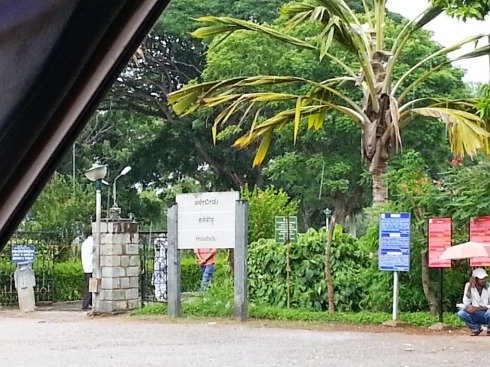
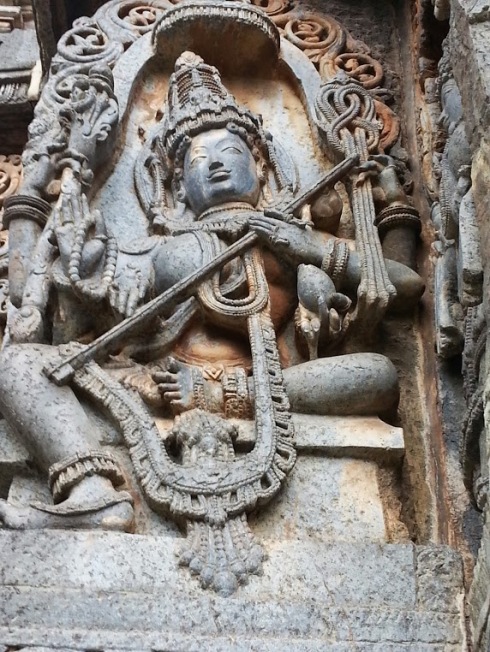
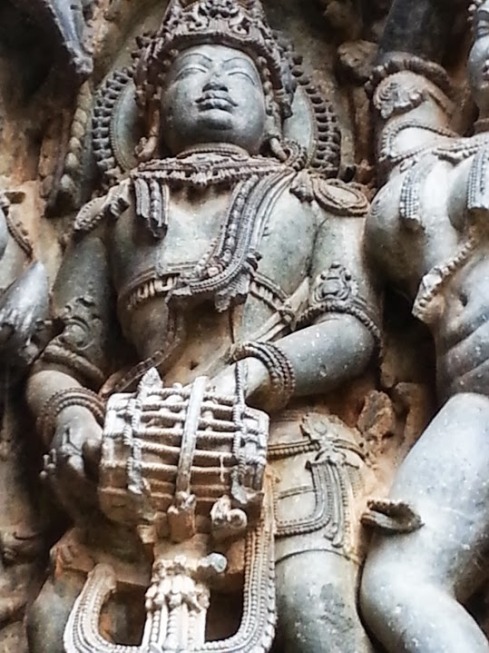
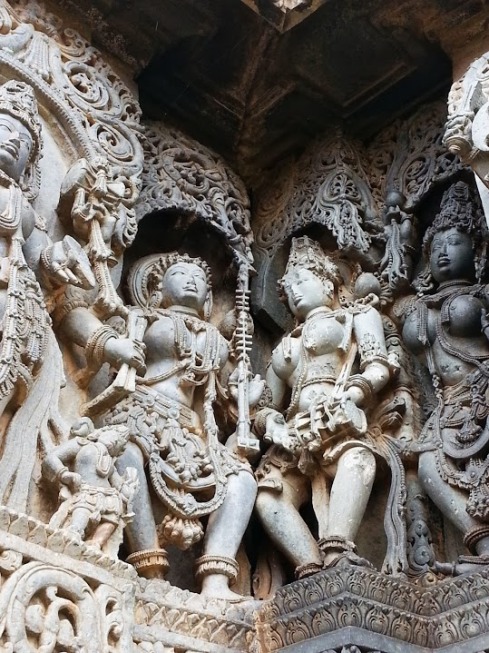
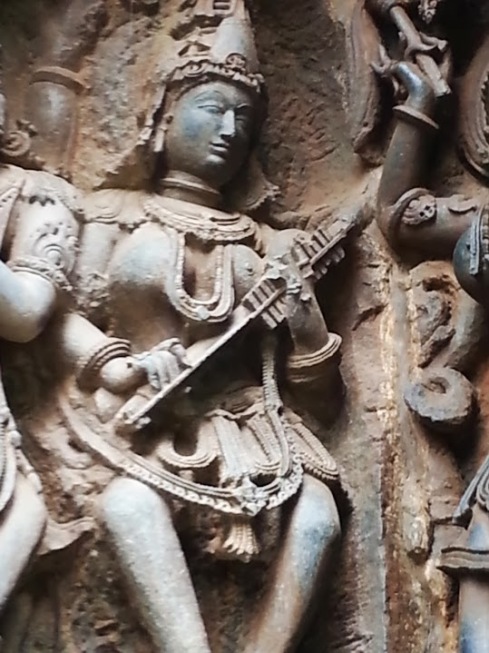
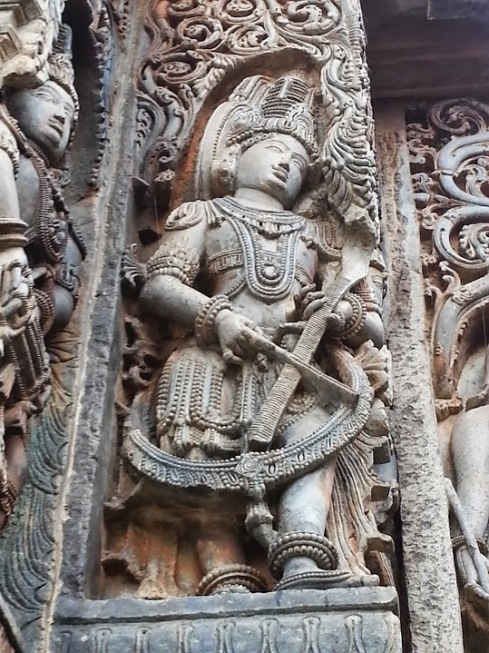
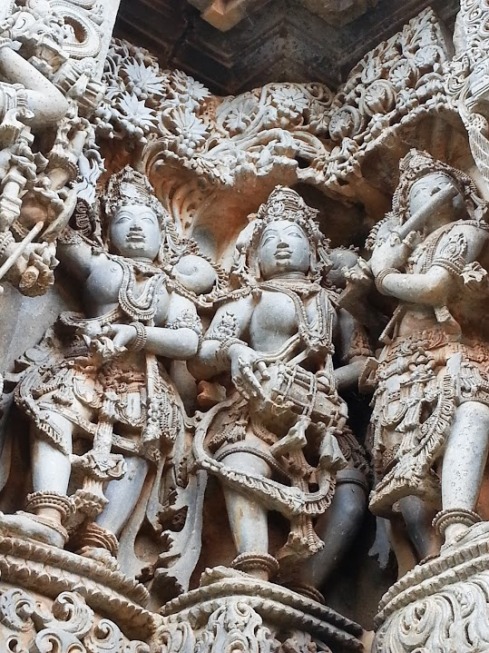




ಇತ್ತೀಚಿನ ಟಿಪ್ಪಣಿಗಳು